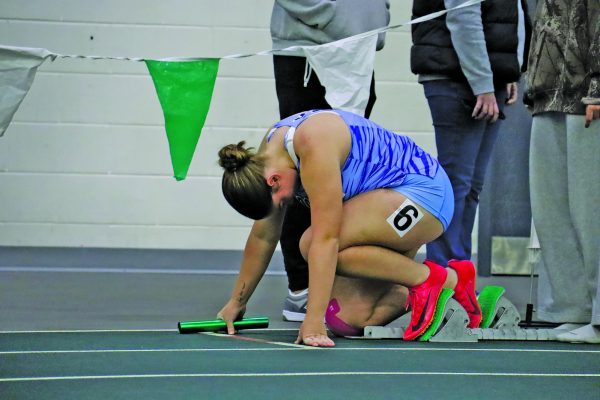Documenting a long history of sexual abuse
Athletes featured in the documentary
On June 24, 2020, Netflix released its newest documentary, “Athlete A.” The documentary gives an in-depth view of the Larry Nassar sex abuse scandal and downfall of USA Gymnastics. It follows the journalists of the Indianapolis Star who began reporting and publishing the first stories of the scandal.
The documentary begins a narration of Oklahoma Sooners gymnast Maggie Nichols practicing at her university’s gym. She speaks about the rush and sensation she feels whenever she is competing. Nichols was one of the top elite gymnasts in 2015 who was getting ready to compete to earn her spot on the National Team for the Rio de Janeiro Olympics. Nichols did not make the team because her coach reported Nassar to USA Gymnastics (USAG) when Nichols talked about what Nassar had done to her.
It moves on to the newsroom of the Indianapolis Star. Steve Berta, an investigations editor, takes over the narration to speak about how the stories of the scandal came to the surface. During the Rio Olympics, the first story about a possible sex abuse scandal at USAG was published. The research for this story brought up a former lawsuit against a coach who moved from team to team as USAG was aware of his misconduct. Savannah Metro, the gymnast who came forward, was not protected by the organization for the sexual abuse she faced.
The documentary shows videos clips from news that broke headlines the day after the National Team won the team gold medal in Rio. After the news stories started to get media coverage, gymnasts’ testimonies were featured. There are scenes of former gymnasts competing throughout the past three decades and each tells their story of the abuse they suffered. There is an emotional impact that I felt while watching these scenes. These women all suffer from post-traumatic stress disorder (PTSD) and watching their interviews showed that speaking about their abuse still affects them to this day.
Images of where the abuse took place painted the picture the Indianapolis Star was telling throughout the documentary. The music was calming during the interviews with the journalists, survivors, but was dramatic when videos or images of Nassar appeared. The video evidence of Nassar abusing gymnasts was heart-wrenching to view, even though the abuse was not pictured. I watched this documentary three times, and each time Nassar’s face was shown or his name was mentioned, I flinched. I felt uncomfortable learning about everything he had done even after hearing about it countless times.
The ages of the gymnasts ranged from 12 all the way to 21, comprising all levels of gymnastics. The sexual abuse these girls faced was the worse form they received but by no means the only form. The gymnasts faced verbal abuse from coaches and the National Team coordinators. Elite gymnasts appeared skinnier than those who competed at the college level who looked athletic. Emotional and physical abuse became the norm for elite gymnasts who had to face Nassar’s “treatments” and playing with extreme injuries.
The documentary goes on to talk about the famous Karolyi Ranch in Texas where the national team train. This ranch is owned by former team coordinators and head coaches Bela and Martha Karolyi.
From the age of 15, gymnasts who are training for their first Olympics head to the ranch without their parents or cell reception. The only adults there are the team doctors, coaches and the Karolyi’s. Once Maggie Nichols arrived for her first summer of training, she found out from fellow gymnast Aly Raisman that the abuse was part of the training. Nichols’ coach heard the conversation and passed it along to the former USAG President, Steve Penny. Nothing happened and no one heard Nichols’ story.
The allegations against Nassar seemed off to USAG and the Karolyis. Nassar was known by coaches and gymnasts to be the nicest person in the program.
Before the sexual abuse started, Nassar would be the person to whom gymnasts would go for relief from the abuse they were getting from their coaches. This was the way he gained trust of the young girls in order to begin his grooming.
Throughout the documentary, we learn more about Nichols’ story. It shows scenes from the US Olympic Trials and we learn that she was not being watched by Martha Karolyi as she had been the year prior. Nichols’ allegations a year before the trials meant she would never compete at the Olympic level under Steve Penny’s tenure.
There are scenes that show Nassar talking to Michigan State University Police about a lawsuit that was dropped in 2014.
As the questioning about his medical practice moves into uncomfortable information, he gets nervous and does not understand how he could have done anything related to sexual assault to young women. After more media press about Nassar, hundreds of former gymnasts that were abused by him came forward.
The documentary follows the timeline of the investigative team at the Indianapolis Star and the research they found to see patterns of cover-ups.
These cover-ups of Nassar’s crimes were done by Michigan State University and USAG to maintain their reputations. There was a 13-month period from the time Steve Perry reported Nassar to the FBI during which Nassar was able to sexually abuse more young athletes while working at MSU. Student athletes began to file complaints and Nassar was fired.
Police investigation found over 30,000 images and videos of Nassar’s abuse at his home. He pled guilty to the possession of child pornography, which in Michigan carries a minimum 25-year sentence. He broke federal laws by having the intent to harm or cause sexual crimes overseas as the team doctor for the National Team.
One hundred and twenty-five survivors, who came out publicly, were able to testify in front of Nassar and the judge about his abuse. The scenes from the impact statements of survivors drives the emotional impact this documentary has. The statements all told the same story about what Nassar was doing to young, innocent girls who were trying to take care of life-altering injuries. Maggie Nichols was identified as “Athlete A” by the USAG, United States Olympic Committee, and MSU.
This is a hard documentary to watch based on the subject itself. As a journalist and athlete, I felt the urge to watch and report on this. This was the largest sex abuse scandal in sports history and this documentary tells the story in the easiest way possible to understand how horrible the USAG’s abuse was towards gymnasts. As someone who suffers from PTSD and anxiety myself, I urge you to pause and take your time watching this.

Senior, Pre-Law & Journalism
Grew up in Middle Town, NY
Fall 2019 - Present
My spirit animal is a Narwhal because they are the aquatic unicorns!







